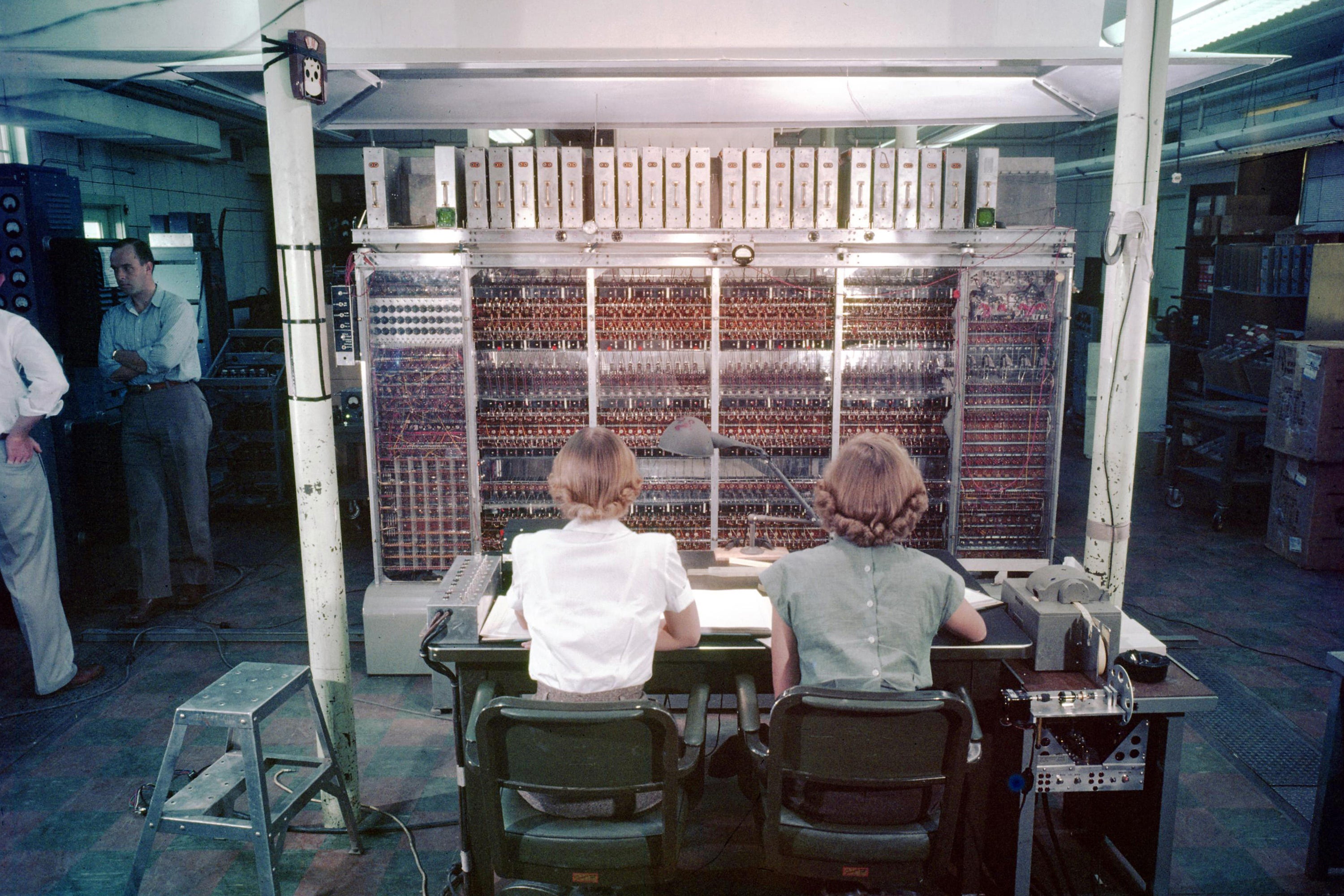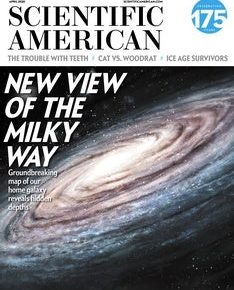
In 1952, at Los Alamos Scientific Laboratory, theoretical physicists Enrico Fermi, John Pasta and Stanislaw Ulam brainstormed ways to use the MANIAC, one of the world’s first supercomputers, to solve scientific problems. At the time, problems were solved by performing either laboratory experiments or mathematical calculations by hand. Fermi, Pasta and Ulam wanted to use their new problem-solving tool—computer simulation—to virtually zoom in on a system and observe atomistic interactions at the molecular level, with a realism that was not possible before.
They chose to simulate a chain of point masses connected by springs, designed to represent atoms connected by chemical bonds, then observe what happened to energy as it moved around on the chain. The system, which resembled objects on a vibrating string, was important because it was nonlinear—unable to be solved by being broken into smaller pieces. Interactions between atoms are universally nonlinear, but they couldn’t be observed with a microscope. This experiment on the MANIAC would allow scientists to virtually observe, for the first time, interactions between individual atoms.
Fermi, Pasta and Ulam designed the experiment; a programmer named Mary Tsingou made it happen. Tsingou wrote an algorithm, programmed the MANIAC, and ran the simulation over and over, along the way making adjustments, debugging and altering input to compare results. Fermi, Pasta, and Ulam thought the energy would spread out along the chain and eventually reach equilibrium, but it kept moving, never settling anywhere. The scientists were surprised by the results, and the experiment gave birth to the field of nonlinear science, which includes a wide array of scientific and mathematical areas of study, such as chaos theory. “Nonlinearity is the great frontier of science,” says Steven Strogatz, a professor of mathematics at Cornell University. This particular experiment, he says, “was one of humanity’s first attempts to see what lurks out in these borderlands.”
The experiment has historically been named the Fermi-Pasta-Ulam problem, or FPU, for the three physicists who authored the 1955 report, but many scientists now refer to it as the Fermi-Pasta-Ulam-Tsingou problem, or FPUT. In the original Los Alamos report, a column lists “work by” the three authors plus Mary Tsingou, and the first page includes a footnote reading, “We thank Miss Mary Tsingou for efficient coding of the problems and for running the computations on the Los Alamos MANIAC machine.”
Mary Tsingou Menzel is a very humble scientific game changer. Still living in Los Alamos with her husband, Joe Menzel, she expresses surprise at the significance of the experiment she programmed almost 70 years ago. She also continually asserts that she has never felt slighted by not being included in the naming of the problem. “It never bothered me,” Tsingou says. “They did acknowledge that I did the programming.”
The impact of the experiment on modern science is difficult to overstate. “Nonlinear science destroyed the clockwork view of the classical universe by showing how chaos places limits on predictability,” says David Campbell, a professor of physics at Boston University. “Nonlinear studies are now a part of the canon of modern science.”
Most systems are, in fact, nonlinear. “Quantum gravity, cancer, the immune system, the economy, the resilience of ecosystems, the origin of life, climate change—all of these problems are characterized by thickets of feedback loops and interactions among the various parts of the systems that make the whole more or less than the sum of its parts,” says Strogatz. These types of systems could not be studied before computer simulation, and computer simulations could not take place without programmers.
Tsingou originally came to work at Los Alamos as a mathematician, but when the opportunity arose, she became one of only a few people at the time who learned to program the MANIAC. It was then that she began working with Fermi, Pasta and Ulam in a theoretical group that had been given use of the MANIAC, and she became instrumental in a groundbreaking experiment. “We were all sitting there together,” Tsingou remembers, “and they [say], ‘We’ve got this machine; we’ve got to come up with some problems’ that couldn’t be solved before theoretically.” They went through several options but decided to try the vibrating string.
Once she knew what the physicists wanted to test, Tsingou handwrote an algorithm that would be her pathway for obtaining the results. “We made flowcharts,” she says, “because when you’re debugging a problem, you want to know where you are so you can stop at different places and look at things. Like any project, you have some idea, but as you go along, you have to make adjustments and corrections, or you have to back up and try a different approach.”
Running the simulation took years in total, with the final calculations taking place in 1955, after Fermi’s death. “I was the only one who worked on it pretty much regularly,” Tsingou says. The scientists “would work on it and then forget about it for a while and get into another project, then they would call me up and say, ‘Change this a little bit’ or ‘See if putting in more points gets better results.’” So, the process was ongoing for quite some time as results were gathered and analyzed, and changes were made. “They would suggest new things, and we would run it, then they would get involved in other problems and so would I.”
Though a preprint of the 1955 report was read by a few physicists, the experiment wasn’t widely disseminated until Fermi’s collected papers were published in 1965. But eventually, the FPUT’s results revealed a whole new way to think about and test problems that could not be tested before. Since then, the method of using computers to conduct experiments has become standard in many fields. “The FPUT problem revealed the power of simulation,” Strogatz says. “It showed the scientific world that an astonishing new instrument, comparable to the microscope and the telescope, had arrived for exploring previously unexplored worlds.”
Simulation has myriad uses across fields. “Numerical experiments are now central to science and engineering,” says Dvira Segal, a professor of chemistry at the University of Toronto who uses versions of the FPUT chain to conduct numerical studies of heat transport. For example, “since FPUT chains do not exhibit normal heat conductivity,” she explains, “simulating these systems on a computer allows us to uncover mechanisms of anomalous heat transport at the nanoscale—and discern necessary conditions for achieving normal conduction.”
While the impact of the FPUT has long been celebrated, the full story of the people who created it did not start of unfold until the early 2000s, when physicist Thierry Dauxois began to wonder about the name in the footnote. Dauxois was also familiar with a paper published on the FPU in 1972 by James Tuck and M. T. Menzel. “A careful reading of the introduction reveals that Menzel was involved in the coding of the original problem, but no one by that name is mentioned in the Los Alamos report,” says Dauxois, director of the CNRS Institute of Physics at ENS de Lyon. He deduced that M.T. was Mary Tsingou, publishing under her married name, Menzel. Dauxois had worked at Los Alamos as a postdoctoral researcher, and he used his contacts there to arrange an interview with Tsingou, resulting in his 2008 article in Physics Today that sparked the gradual change from FPU to FPUT.
For many scientists, there is no question that Tsingou’s name should be added to the experiment. “Today, a person who writes a serious computational code to study a problem in any scientific discipline is considered an equal co-author,” Campbell says. “This is in part because there are now three approaches to studying scientific problems: theoretical work, experimental observations and computational studies,” the latter of which encompasses Tsingou’s work on the FPUT. “The discovery relied on Tsingou’s algorithm development, programming, code execution and data collection and analysis,” Segal says. “Given the critical role she played, Tsingou should be regarded as a co-discoverer of this remarkable result that marks the birth of nonlinear science.”
The FPUT was conducted early in Tsingou’s 30-year career at Los Alamos, where she was an expert in the programming language FORTRAN and worked on projects like the Strategic Defense Initiative, known as “Star Wars.” But throughout her entire accomplished career, people called from all over the world to ask Tsingou about the FPUT and to request her work on programming new versions. “From the beginning,” she says, “people have been interested in the vibrating string.”
This is an opinion and analysis article; the views expressed by the author or authors are not necessarily those of Scientific American.
This article is an extension of the author’s previous work in National Security Science.



